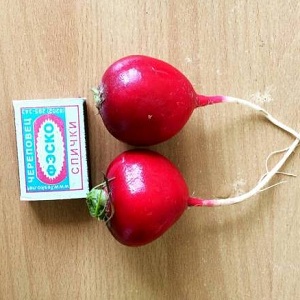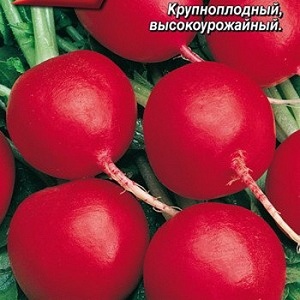A productive and not picky in care variety of Duro radish
The Duro Krasnodarskoye radish variety appeared relatively recently, but quickly won the love of gardeners due to its early maturity, large-fruited nature, pleasant taste of root crops and a long period. storage... Under favorable conditions, radishes grow to the size of an apple, without losing their taste.
From the article you will learn how to grow Duro radishes in open and closed ground, what are its varietal characteristics, advantages and disadvantages.
The content of the article
Description of the variety
A mid-season radish variety with the original name Duro Krasnodarskoe is a product of domestic selection.
The originator is the peasant farm "Bychkov L. M." Culture is included in the State Register of Russia in 2007. Radishes are grown everywhere in open and closed ground.
Distinctive features of the variety are presented in the table.
| Indicators | Characteristic |
| Ripening period | 25-30 days |
| Weight | 23-25 g |
| The form | Round, flat head |
| Coloration | Red |
| Leaves | Obovate, yellow-green in color. Petiole with anthocyanin coloration. The socket is semi-upright. |
| Pulp | White, tender, juicy |
| Taste | Sweet, with a slight bitterness |
| Skin | Thin |
| Yield | 2.4-2.6 kg per sq. m |
Culture characteristics
The short growing season allows radishes to be grown several times per season - from February to September, with an interval of 15 days.
The plant does not shoot, the fruits do not crack, subject to the rules of agricultural technology (weeding, loosening, abundant watering).
With a sparse planting of 7x7 cm, it is possible to grow fruits the size of an apple. Their diameter is 7-10 cm, while voids are not formed inside, and the flesh remains dense and juicy.
The culture is resistant to most cruciferous diseases, but preventive treatments will not hurt.
Duro radish adapts to any growing conditions, so gardeners manage to achieve yields without any problems even in risky farming zones. The plant tolerates heat, cold and long distances, it is stored in a cool place for up to four weeks.
Growing radish
Radish Duro prefers loose and fertile soil, picky about watering and lighting. Sowing begins in February indoors and in March outdoors.
Agricultural technology is standard, does not require special skills. The soil is loosened after watering and weeds are weeded, watered often, but with a moderate amount of water.
Landing
Seeds are pretreated before sowing: calibrated and disinfected in potassium permanganate.
Calibration is the procedure for selecting quality seeds. To do this, they are soaked in a saline solution (1 tsp per 200 ml) for 10-15 minutes. The floating seeds are thrown away, and the remaining ones at the bottom are used for sowing. Then the grains are washed with running water and placed in a glass with 1% potassium permanganate solution for 30 minutes. After all the manipulations, the material is dried and embedded in the prepared soil at the site.
Radishes are grown in sunny areas with light, fertile soil. The beds are dug up and fertilized with humus (2 kg per sq. M), superphosphate and wood ash. River sand or sawdust is added to heavy soil.
The optimum acidity of the soil is 5.5-7. To determine the pH, litmus strips, which are sold in gardening stores, will help. Too acidic soil is deoxidized with lime, dolomite flour or chalk, ash is added to alkaline soil.
For sowing, plots are chosen where strawberries, cabbage, tomatoes, beets, spinach, and legumes have grown before.Seeds are sown in a greenhouse in February, in open ground in April-July.
The bed is dug up with a bayonet shovel, leveled with an iron rake, holes are formed and seeds are sealed to a depth of 1.5-2 cm, with an interval of 4 cm.The width between the rows is 7 cm. Landings tighten with agrofibre until shoots appear.
Care
The rules for caring for radishes are simple:
- Water with warm, settled or rain water as the soil dries. In hot weather, increase the number of watering, arrange sprinkling. It is important not to flood the plants, otherwise the root system will start to rot. For 1 sq. m consume 10-15 liters of water.
- After moistening, gently weed the beds, being careful not to hurt the roots. A little hoe is good for this.
- Top dressing is applied once, using potassium, phosphorus and a small amount of nitrogen (15 g of superphosphate, 10 g of potassium nitrate, 1 liter of ash per 10 liters). It is not advisable to use pure organic matter (manure, chicken droppings) - the fruits become too bitter and tough.
- Thinning is carried out in case of thickening of the plantings, leaving a gap of 5-6 cm between the shoots.
Diseases and pests
Despite its resistance to many cruciferous diseases, if the rules of agricultural technology are violated, the plant weakens and remains defenseless against fungal and bacterial infections.
The table contains the main diseases of radish and methods of treatment.
| Name | Signs | Treatment |
| Powdery mildew | White bloom on leaves and petioles, dry, twisted leaves. | Radomil Gold, Bordeaux liquid for one-time treatment. |
| White rust | White oily coating on the leaves. | Treatment with "Ditan M" preparation, removal of infected plants. |
| Gray rot | Brown spots on the leaves with a gray fluffy bloom. | Treatment with "Fundazol", "Ditan M". |
| Keela | Growths on root crops, sluggish tops. | Soil deoxidation with lime, chalk or dolomite flour for prevention, treatment with copper sulfate (50 g per sq. M) before sowing. |
| Blackleg | Darkening of the petiole base, wilting of greenery. | Spraying plantings with a solution of copper sulfate (25 g of powder, 50 g of laundry soap per 10 liters of water). |
| Vascular bacteriosis | Darkening of veins on foliage, wilting and yellowing of the tops. | One-time treatment with Planriz. |
In the spring of the planting of radishes, the cruciferous flea is infected. To combat the pest, folk remedies and fungicides are used:
- mix tobacco dust, ash, naphthalene and camphor in equal proportions and pollinate the plantings close to the petioles (once a week);
- pour the radish with a solution of ammonia (4 tbsp. l. per 10 l);
- sprinkle the herbs with bay leaf infusion (10 g per 1 liter of hot water);
- spray the radish with a vinegar solution (150 ml of 9% vinegar per 10 l);
- to treat the planting with insecticides "Sherpa", "Decis", "Aktara", "Arrivo" after sunset.
To prevent damage, radishes are covered with thin agrofibre and adhere to the rules of agricultural technology.
Harvesting and application of the crop
Duro Krasnodar ripens quickly - just 25-30 days after sowing, fresh and crispy radishes will appear on your table. The shelf life in the refrigerator is 3-4 weeks.
The fruits are used to prepare spring salads with herbs and vegetables, baked, fried, pickled, added to okroshka and other cold soups. In addition to root crops, tops are good for food. It is added to cold stores, borscht, pickled and frozen for future use.
Recipe for an unusual warm radish salad:
- Wash the root vegetables, cut the tops and cut them into quarters.
- In vegetable oil, fry the onion, cut into half rings, add the radish to it and cook for 7-10 minutes.
- Sprinkle the finished dish with your favorite herbs.
Features of growing in a greenhouse and in the open field
Sowing of Duro radish in open ground is carried out in the second decade of April. Planting dates are shifted depending on the region of cultivation. Optimum soil temperature - + 8 ° С, air - + 15-20 ° С. At first, the beds are covered with agrofibre to protect them from night frosts.
Sowing work in the greenhouse begins in February-March. The room is pre-disinfected with sulfur checkers, the soil is treated with copper sulfate. The seeds are sealed to a depth of 1-1.5 cm with an interval of 3-4 cm. To form the holes, an egg tray is used. The prepared bed is pushed through with cells, thus obtaining even pits. After sowing, the site is mulched with humus or peat.
Reference. After watering, the greenhouse is ventilated to prevent infection with the fungus that causes the black leg disease.
Growing difficulties
Despite the unpretentiousness of the variety, inexperienced gardeners sometimes have difficulties in growing it. The table summarizes the main problems and their causes.
| Problem | Cause |
| No shoots | Poor quality seed or planting in cold and wet soil. |
| No fruits are formed | Low potassium content in the soil, poorly chosen place for sowing (in the shade), thickening of the beds. The soil lacks potassium. |
| Hollow, fresh roots | Excess nitrogen, moisture deficit, excessive deepening of seeds. |
| Fruit cracking and bitter flesh | Lack of moisture or excessive watering after prolonged drought. |
| Shooting | Root damage during weeding, dry weather, poor quality or old seed. |
Advantages and disadvantages
Positive traits:
- early maturity;
- high productivity;
- large-fruited;
- excellent taste;
- excellent presentation;
- unpretentious care;
- amicable ripening.
disadvantages:
- with a regular lack of moisture, the roots crack;
- when the root system is damaged, the plant shoots.
Reviews
Reviews of gardeners about the Duro Krasnodarskoye radish variety are mostly positive. Units have negative impressions of growing.
Elena, Kurgan: “This radish was a real discovery for me last year. The fruits are large, not bitter, not hollow inside, not dry, the skin is thin. Growing culture is a pleasure. I plant the seeds 1 cm deep with an interval of 8-10 cm. Thus, I save myself the need to thin out the greens and facilitate the care of the plantings. "
Sergey, Ivanovo: “I heard a lot of positive reviews about Duro radishes, so I decided to try planting them at the dacha. The variety disappointed me. Sowed three times. Instead of large fruits, I got a small radish with huge tops. Perhaps she did not have enough sun, as the summer turned out to be cool. "
Victor, Bryansk: “This is one of the best varieties of radish. Seedlings appear quickly after sowing, the harvest ripens synchronously. Root crops are large, juicy, not sinewy. The taste is sweet, with a slight spice. Sometimes it is possible to collect just huge fruits. Their skin is a little rough, but this does not affect the taste. "
Reading also:
Unusual-looking and pleasant-tasting watermelon radish: what is good and how to grow it.
Sora radish, which is early ripening and very popular among summer residents.
Care of the Celeste radish hybrid for tasty and large fruits.
Conclusion
Radish cultivation is a feasible task even for a novice gardener. The Duro Krasnodarskoe variety is one of the unpretentious crops, characterized by an early ripening period, high productivity, lack of bitterness and voids in fruits, strong immunity.
Agricultural technology of the variety comes down to sufficient watering, loosening and weeding of the beds. Potassium-phosphorus fertilizing with nitrogen is applied once. The crop is harvested in 25-30 days, stored in a cellar or refrigerator for 3-4 weeks.